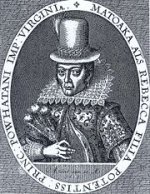|
 Born around 1595 in what is now the Tidewater region of the State of Virginia, United States, Pocahontas was a daughter of Powhatan, a powerful Algonquian Indian chief. Her given name was Matoaka, though she is known to history by her nickname, Pocahontas, which means "Little Wanton," or playful little girl. She was one among many of Powhatan's children born of his numerous wives. Some historians suggest that she was a favored child of the great chief. Born around 1595 in what is now the Tidewater region of the State of Virginia, United States, Pocahontas was a daughter of Powhatan, a powerful Algonquian Indian chief. Her given name was Matoaka, though she is known to history by her nickname, Pocahontas, which means "Little Wanton," or playful little girl. She was one among many of Powhatan's children born of his numerous wives. Some historians suggest that she was a favored child of the great chief.
Pocahontas first enters the European historical record in Captain John Smith's memoirs of his Virginia adventures. His romanticized version of their meeting – in which she successfully begs her father to spare Smith’s life – is at minimum, exaggerated, and may well be a total fiction. Smith was known for self-aggrandizement and stretching the truth.
What is known is that Pocahontas was a frequent and friendly visitor to the Jamestown Fort. She was apparently fond of Smith and enjoyed conversing with him when she visited. At the time she was about ten years old, so any romance between the two seems unlikely. Smith later described her appearance as having "much exceedeth any of the rest of his [Powhatan’s] people but for wit and spirit [is] the only non-pariel of his countrie."
Within a few years relations between the Jamestown settlers and the Powhatan Indians worsened. Pocahontas did not visit the fort as she did before, though probably this was not her choice. When she visited in late 1609 she was told that Smith had died, though in fact he had suffered a serious burn from a gunpowder explosion and had to return to England.
The historical record suggests that in about 1610 Pocahontas married an Indian man named Kocoum, and went to live among his people in the Potomac region. From that point on Pocahontas’ life went through a series of major changes and adjustments. Not long after she settled with her new husband, she was tricked into boarding a ship captained by Jamestown resident, James Argall, who sent word to Powhatan that his daughter would be released only after English prisoners were returned to Jamestown. Powhatan did not respond right away, and even when he did, he paid only part of the ransom. He did, however, ask the English to treat his daughter well. She was then held at Jamestown for a while, then moved to a new settlement upriver, called Henrico. It was there that she converted to the Christian faith, began to live and dress in a more European manner. It was also where she met her English husband, tobacco farmer John Rolfe. During this time she was still technically a captive. Later, after attempting to obtain Pocahontas' full ransom in a fierce battle with the Powhatan Indians, she was reunited with two of her brothers, and told them she was being treated well. She also told them that she was in love with John Rolfe and wanted to marry him. Powhatan granted approval for the marriage, though John Rolfe struggled with his own decision to marry outside his religion and race. He finally decided to go ahead with the marriage, and the two were wed on April 4, 1614. Thus began the period known as the Pocahontas Peace, when English and Indian made their best effort to get along.
In 1616 Pocahontas, along with her husband and their young son, Thomas Rolfe, traveled to England for a seven-month stay. She was an instant celebrity, and attired in the latest London fashion, she was presented to King James I, his family, and members of the nobility. Everyone wanted a look at the “Indian princess.” Captain John Smith was in London at the time and met briefly with Pocahontas, who was apparently angry with him for leaving Virginia without saying goodbye. Overall Pocahontas enjoyed her stay in London. In March 1617 the family set sail for Virginia. Pocahontas was very ill at the time, possibly with pneumonia or tuberculosis. It was believed she would not survive the voyage and so she was taken to shore. As she lay dying she remarked to her grieving husband, saying, "all must die. 'Tis enough that the child liveth." She was only twenty-two years old at the time of her death. She is buried in Gravesend, England.
Image: A 1616 engraving of Pocahontas by Simone van de Passe. The original English caption (not visible here) reads "Matoaks als Rebecka daughter to the mighty Prince Powhatan Emperour of Attanoughkomouck als Virginia converted and baptized in the Christian faith, and wife to the wor.ff Mr. John Rolfe ."
|